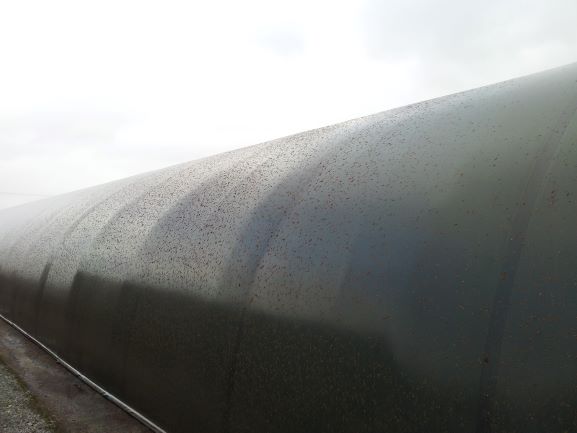Please click here to access the main AHDB website and other sectors.
- Home
- Knowledge library
- How to manage Trichoderma aggressivum in mushrooms
How to manage Trichoderma aggressivum in mushrooms
Read findings on the best general disease management strategies for Trichoderma aggressivum, including specific advice on managing compost facilities, haulage contractors and growing facilities.
General disease management strategies
Mushroom farms should have strict procedures in place to protect against this aggressive disease. All composters, haulage contractors and growers need to adhere to them at all times.
- Implement routine detection/monitoring procedures for Trichoderma aggressivum
- Monitor compost temperatures and/or increased cooling demand
- Continuously inspect compost for the presence of the disease
- Sensibly allocate staff, mindful of hygiene requirements
- Pay additional attention in any situation that involves breaking up or mixing compost
- Where infection is detected, immediately implement specific precautions and immediately notify the rest of the production chain
- Use end-of-process steam sterilisation, and test to make sure the infection is gone
Growers should also follow specific measures for each stage of the production process, as below.
Compost facilities
Regular routine cleaning, disinfection and rinse programmes should be followed in compost facilities, and the handling and storage of mushroom spawn should be carefully managed.
Train all staff to monitor for issues. Test your crops as soon as there’s a sign of a problem.
Air plate and swab sampling, together with regular compost tests, will show you whether your hygiene measures are working. You can carry out a risk assessment to find out how often you should be testing samples.
- Where possible, the filling and emptying of Phase 3 tunnels should be done at different ends, and with dedicated equipment for each activity to ensure there’s no cross-contamination
- Machinery and equipment used in Phase 2 and 3 productions should be segregated
- Never use Phase 3 equipment for Phase 2 processes
- Remove all visible compost debris before cleaning equipment and machinery
- Be mindful of and regularly tackle greasy residues and biofilms that naturally build up on equipment
- Regularly clean, disinfect and rinse the emptying winch
- During the bulk spawn run process, examine both the compost temperature and cooling demand data – if there are subtle unexplained increases, it’s time to test
- It is critical to steam cook-out or pasteurise tunnels between batches of Phase 3 compost
If Trichoderma aggressivum is detected:
- Tell your haulage contractors and growers
- Check companion loads for commonality
- Use critical control point sampling to locate and isolate all infection points
- Increase the frequency of your compost sampling and consider more sophisticated testing methods, such as real-time PCR
- Clean, disinfect and rinse the emptying winch after each tunnel
- Load compost truck by truck (do not mix compost loads)
- Monitor loading the trucks by air plate exposure

An example of a freshly cleaned mushroom growing and compost site
Haulage contractors
This is a critical link in the production chain, as there is regular movement between compost and growing facilities. Putting in extra measures will help you isolate the infection instead of spreading it.
- All equipment that moves between facilities should be cleaned, disinfected and rinsed (inside and out) frequently – at the very least between every location
- Be particularly careful to remove all visible compost debris
- Growing rooms should be filled in sequence load by load – do not mix compost loads
- Implement monitoring procedures at filling, i.e. compost temperatures and air plates
Grower facilities
Filling Phase 3 compost should only be carried out after the receiving growing room and adjacent concrete aprons have been thoroughly cleaned, disinfected and rinsed. Don’t empty crops at the same time and remember to keep all growing rooms closed.
- All machinery, equipment and people involved in filling Phase 3 compost should be segregated
- Remove any compost debris and thoroughly clean all equipment and machinery, such as conveyors, filling heads and rufflers, before and immediately after use
- Regularly tackle greasy residues and biofilms that naturally build up on equipment
- Implement routine monitoring with air plate and swab sampling to make sure your hygiene procedures are working
- Monitor compost temperature on arrival and regularly in the days immediately after filling
- Be vigilant in the critical 3–5 days after filling Phase 3 compost: look for white strappy mycelial growth, green sporulation, increases in compost temperature and an unusual smell
Steam cook-out at the end of every crop is the most effective measure you can take to minimise the spread of disease. Do this at a temperature of 65–70˚C in the compost for a minimum of 8 hours.
If Trichoderma aggressivum is detected:
- Tell your composters and haulage contractors
- Restrict all but essential access to the farm
- Use critical control point sampling to locate and isolate all infection points
- Increase your hygiene measures
- Pay attention to common areas (canteens, toilets, offices, pack-sheds) and equipment (interface panels, computer keyboards, telephones, etc.)
- Be aware of potential cross-contamination, especially when compost is mixed or Agaricus mycelium is broken up, e.g. reconsider second ruffle, if appropriate
- Pay particular attention at filling – do not mix loads, fill compost straightaway, reconsider the addition of water
- Carry out an end of crop steam sterilisation (65–70ºC in the compost for a minimum of 8 hours), applied both with compost in the growing room and when it is removed

An example of compost dust on a growing tunnel rood after tunnel emptying
Useful links
Find out the symptoms of Trichoderma aggressivum
Monitoring Trichoderma aggressivum
Images are courtesy and copyright of: Mairead Kilpatrick (AFBI), Johan Baars (C4C Holding), Piet Liempens (Hooymans Compost BV), Brendan Burns (Sylvan) and Roland Mumm (Wageningen UR)

